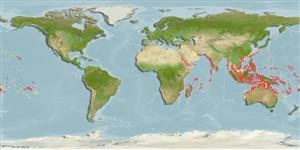Environment: milieu / Klimaatzone / Diepte / distribution range
Ecologie
marien rifbewoner; diepte 0 - 60 m (Ref. 128797). Tropical; 32°N - 32°S, 30°E - 132°W
Indo-Pacific: Red Sea south to Natal, South Africa (Ref. 4420) and east to the Line, Marquesan and Tuamoto islands, north to southern Japan, south to the southern Great Barrier Reef and New Caledonia.
Lengte bij maturiteit / Grootte / Gewicht / Leeftijd
Maturiteit: Lm 15.7, range 8 - ? cm
Max length : 30.0 cm TL mannelijk / geslacht onbekend; (Ref. 2334); common length : 26.0 cm TL mannelijk / geslacht onbekend; (Ref. 5450)
Korte beschrijving
Determinatiesleutels | Morfologie | Morfometrie
Dorsale stekels (totaal) : 3; Dorsale zachte stralen (totaal) : 24 - 27; Anale stekels: 0; Anale zachte stralen: 20 - 24. This species is distinguished by the following characters: front of eye without the elongate groove; enlarged scales above the pectoral-fin base and just behind the gill opening to form a flexible tympanum; the scales of the caudal peduncle with 2 longitudinal rows of large anterior-projecting spines; the slightly rounded caudal fin with compressed peduncle; head and body colour green to brown with diagonally curved orange lines and a large round black blotch covering most of the caudal-fin base; rays of soft dorsal, anal and pectoral fins orange and also the caudal fin (Ref. 10920, 9770).
Body shape (shape guide): short and / or deep; Cross section: oval.
Adults which are territorial in nature occur in coral-rich areas of deep lagoon and seaward reefs from the lower surge zone to at least 50 meters (Ref. 48637). They feed on a variety of benthic organisms such as algae, echinoderms, fishes, mollusks, tunicates, sponges, and hydrozoans. Eggs are laid as one cluster in a shallow excavation on sand or rubble along channels. (Ref. 1602). Marketed fresh and dried-salted (Ref. 9770).
Spawning behaviour may involve loose aggregations and nesting occurs in channels. The eggs are laid in a single spongy cluster in a shallow excavation in rubble or sand. Hatching occurs at night (Ref. 37816). Nests are guarded by one or at times two adults (Ref. 9778).
Matsuura, K., 2001. Balistidae. Triggerfishes. p. 3911-3928. In K.E. Carpenter and V. Niem (eds.) FAO species identification guide for fishery purposes. The living marine resources of the Western Central Pacific. Vol. 6. Bony fishes part 4 (Labridae to Latimeriidae), estuarine crocodiles. FAO, Rome. (Ref. 9770)
Status op de Rode Lijst van het IUCN (Ref. 130435: Version 2025-1)
Gevaar voor de mens
Traumatogenic (Ref. 4420)
Gebruik door de mens
Visserij: commercieel; Aquarium: Commercieel
Tools
Speciale rapporten
Download XML
Internetbronnen
Estimates based on models
Preferred temperature (Ref.
123201): 25.1 - 29.1, mean 28 °C (based on 1034 cells).
Fylogenetische diversiteitsindex (Ref.
82804): PD
50 = 1.0000 [Uniqueness, from 0.5 = low to 2.0 = high].
Bayesian length-weight: a=0.02884 (0.02323 - 0.03580), b=2.93 (2.87 - 2.99), in cm total length, based on LWR estimates for this species (Ref.
93245).
Trofisch niveau (Ref.
69278): 3.4 ±0.42 se; based on food items.
Weerstandsvermogen (Ref.
120179): Gemiddeld, minimale populatieverdubbelingstijd 1,4-4,4 jaar (Preliminary K or Fecundity.).
Fishing Vulnerability (Ref.
59153): Low vulnerability (20 of 100).
🛈
Nutrients (Ref.
124155): Calcium = 45.5 [19.1, 112.8] mg/100g; Iron = 0.609 [0.316, 1.378] mg/100g; Protein = 18.4 [16.3, 20.5] %; Omega3 = 0.118 [0.060, 0.227] g/100g; Selenium = 34.2 [17.9, 70.8] μg/100g; VitaminA = 56.4 [16.5, 196.9] μg/100g; Zinc = 1.07 [0.73, 1.59] mg/100g (wet weight);
